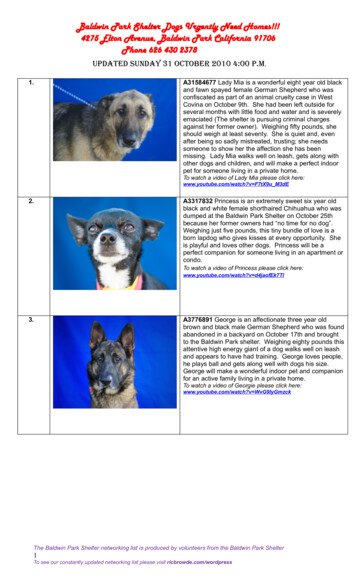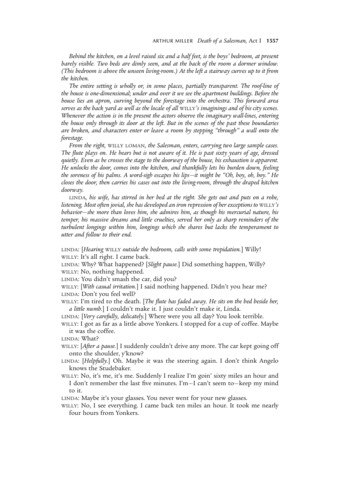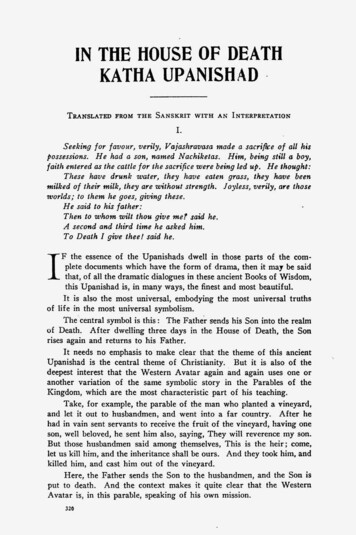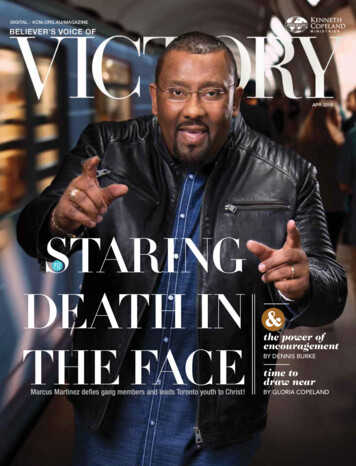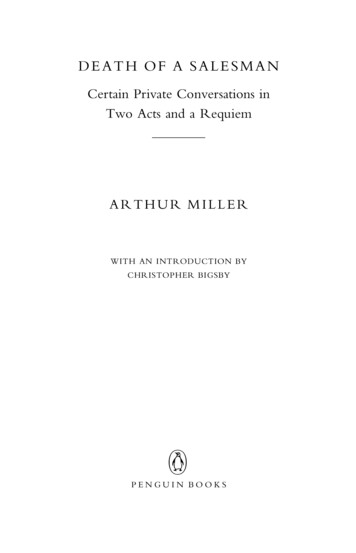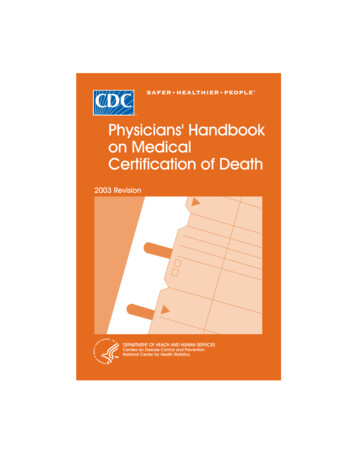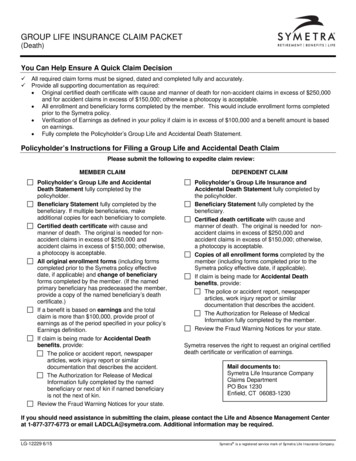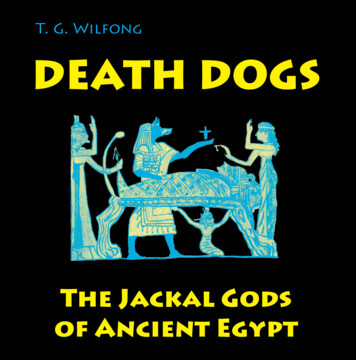
Transcription
DEATH DOGS
T. G. WilfongDEATH DOGSThe Jackal Godsof Ancient EgyptKelsey Museum Publication 11Ann Arbor, Michigan 2015
For Greg MaddenThis book is a catalogue for the exhibition “Death Dogs: The Jackal Gods ofAncient Egypt,” on display at the Kelsey Museum of Archaeology, University of Michigan, 6 February–3 May 2015.Front cover image adapted from fig. 124.Back cover image adapted from fig. 35.The trademarks and commercial names and products used on pages 108–113are the property of their respective rights-holders. They are included foreducational and informational purposes only; their inclusion does not implyendorsement of, or by, the Kelsey Museum of Archaeology or the Universityof Michigan.Dates in this publication are adapted from the chronology in Digital Egyptfor Universities: gy/index.html.Published by:Kelsey Museum of Archaeology434 South State StreetAnn Arbor, Michigan /publications Kelsey Museum of Archaeology 2015ISBN 978-0-9906623-1-0
ContentsPreface 7Death Dogs Origins 9Meet the Death Dogs 18Death Dogs in Action 43Graeco-Roman Death Dogs 64Death Dogs into the Present 96Acknowledgments 114Image Credits 116Bibliography 117Indices 123About the Author 127
Fig. 1. Anubis asembalmer, from thecoffin of Djehutymose,625–580 BC (KM1989.3.1).
PrefaceI’ve been fascinated by the ancient Egyptian jackal gods since I was a kid,but I can still remember my ten-year-old disappointment at finding out thatthe bright yellow book I had bought with a jackal god on the cover (fig. 180)was not, in fact, a book about Anubis. Hopefully the book you hold in yourhands now will better live up to its cover.The initial idea for this exhibition and its catalogue came as I was working on my book on the Kelsey Museum’s coffin of Djehutymose, a priest ofthe Saite Period (Wilfong 2013a). In choosing images from the coffin andlooking for supporting material from the Kelsey collections, I was struck byall the jackal gods I was finding. I wasn’t able to use all the material I foundin the coffin book, and the idea of doing an exhibition to pursue these godstook root.Another impetus came during preparations for my 2011–2012 exhibition “Karanis Revealed” (Wilfong and Ferrara 2014). I hadn’t expectedthat this project would involve jackal gods, but they kept coming up—thejackals on the funerary stelae from the site of Terenouthis, the faiencejackal head, and, especially, the coffin panel with an image of the jackal godAnubis from Karanis. And dogs kept appearing in archival photographs ofthe Michigan excavation, something I later wrote about (Wilfong 2013b).Meanwhile, Andrew Ferrara, my assistant on the exhibition, had adopteda replica Anubis head (fig 180) as our office mascot, around which Anubis-themed toys and games (along with a plush Sobek, fig. 177) began toaccumulate, as another theme for the present exhibition began to cometogether.Early in the research for the exhibition, I kept returning to certain 19thand early 20th-century books for images and inspiration. In the Kelsey Museum library, I went through facsimiles of wall reliefs and funerary papyri,while in Kelsey Museum storage I explored the Kelsey’s copy of the lavishDescription de l’Égypte as sources of images of jackal gods, supplemented byvintage volumes in my own collection. Although often outdated in scholarship, these volumes have beautiful illustrations that are, in themselves, worksof art and testaments to the printing craft that produced them.7
Looking at the 19th- and early 20th-century sources for the jackal godsmade me think about what came before. I’ve long been interested in the early dissemination of images of ancient Egypt through the works of 17th-century proto-Egyptologist Athanasius Kircher and, while preparing a lectureon Kircher, came across a jackal god illustration that had a long-lastingimpact (fig. 163). My late friend Dominic Montserrat was an avid collectorof 17th- and 18th-century prints of Egyptian artifacts, and by chance he hadgiven me one that showed a jackal god in fanciful form, which led me to seekout even more.My work on the Egyptian jackal gods owes much to the work of Terence DuQuense, an independent scholar who devoted much of his life to thestudy of these deities. DuQuense’s passion for his subject resulted in an extensive body of authoritative scholarship that is essential reading for anyoneinterested in Anubis, Wepwawet, and the other Egyptian jackal gods. Hisunexpected death in April 2014 was a great loss to us all and cut short workon his magnum opus: the planned multivolume Jackal Divinities of AncientEgypt. The sole volume of this work published to date (DuQuense 2005),along with DuQuesne’s other publications, underlies much of what you willread in the following pages.My friend Greg Madden has encouraged and supported me in my endeavors, Egyptological and otherwise, for over thirty-five years and counting:this book is for Greg.T. G. WilfongExhibition Curator8
Death Dogs OriginsIntroductionJackal gods are among the most recognizable and vivid symbols of ancientEgypt, but they are rarely considered as distinct individual beings. These canine gods, associated with the dead and the afterlife, are immediately identifiable as “Egyptian” but not so well known or well understood. These “DeathDogs” may seem hostile and fierce to us but were, in fact, protective andhelpful to the ancient Egyptians, assisting them from death into the afterlife.The Egyptian jackal gods were usually represented with jackal heads onhuman bodies or entirely as animals and, as such, were distinctively Egyptiandeities. They served essential functions in the Egyptians’ understanding ofwhat happened after death, acting as guides and protectors in the complexprocess of reaching the afterlife.We do not know exactly when and why ancient Egyptians began associating jackals and other canines with funerary gods. But the association beganat some point in prehistory, perhaps from observations of these animals’scavenging habits. Already in the Predynastic period (ca. 5200–3100 BC),jackals had become identifiable symbols of the gods of specific towns, andthey appear in some of the earliest written documents to survive from Egypt.They are among the earliest funerary gods in Egypt and remain prominentsymbols in Egyptian religion for more than 3,000 years.Through ancient Egyptian artifacts from the Kelsey Museum of Archaeology and the University of Michigan Library Papyrology Collection,this exhibition explores the changing roles and identities of these jackalgods in Egyptian belief and practice, using more recent images and objectsfrom the 17th century to the present to follow these gods into the modernworld. Although not physically a part of the exhibition, the Kelsey Museum’s elaborately decorated coffin of Djehutymose (an Egyptian priest whodied around the years 625–580 BC) supplies imagery used throughout theexhibition and this publication to show details of how the jackal gods appear on this coffin:9
Fig. 2: Jackal gods in a procession: Anubis(left) and Duamutef (right), from the coffin ofDjehutymose, 625–580 BC (KM 1989.3.1)The coffin of Djehutymose, a priest of Horus of EdfuWood, gesso, paint; 181.25 cm h., 52.5 cm w. (widest), 54 cm d. (deepest)Ca. 625–580 BCNag el-Hassiya, EgyptDonation of Albert M. ToddKM 1989.3.1Figs. 1–2, 21, 29–30, 34, 46, 54–58, 69, 71, 85, 87, 9210
Jackal God PlacesThe jackal gods were worshipped throughout Egypt. This map shows someof the more important centers, as well as the places where objects in this exhibition were made or found.Mediterranean SeaAlexandriaTerenouthisSaqqaraSoknopaiou )rNile RiveRed SeaAsyut(Lykopolis)AbydosDeir el-BahriDenderaCoptosThebes (LUXOR)EsnaN00100 miles100 kmEdfuASWAN11
Jackal, Dog, Wolf, or Fox: What Is This Sacred Animal?Egyptian representations of the canine animal associated with funerary godsare remarkably consistent, but the precise identity of these animals is hard todetermine (see Osborn 1998, 55–79 for a summary). They most closely resemble jackals in form and size (the golden jackal, Canis aureus, being the jackalknown to the ancient Egyptians), but the black coloring typical of the sacredanimal does not appear in any jackal found in ancient Egypt.The Greeks and Romans often called these animals dogs or wolves.Wolves were not present in Egypt, although the Egyptians certainly had domestic dogs as pets, work animals, and wild strays (Brewer et al. 2001, 28–48).But Egyptian representations of dogs do not correspond directly to theirrepresentations of the sacred animal. One scholar suggests that the animalswere foxes, which did exist in Egypt (Osborn 1998, 78–79), but foxes did notFig. 3: Object 1: Wooden jackal figure (onmodern base)12
Fig. 4: Jackal hieroglyph from false door inscription of Qar nicknamed Pepi-Nefer, 6thDynasty (ca. 2300–2181 BC) (KM 1981.4.1)Fig. 5: Representation of dog from the tomb ofKhnumhotep at Beni Hasan, 12th Dynasty, reignof Amenemhat II (ca. 1914–1878 BC) (from Griffith1900, pl. 2)reach the size of the sacred animals depicted in Egyptian art or regularlyshow their black color. What is clear is that, although the jackal is theclosest, no single canine embodies all the features of the Egyptian sacredanimal.This ambiguity about the sacred animal is probably intentional sinceEgyptian representations of animals are usually specific and identifiable.Dogs, for example, appear as distinct breeds that resemble modern salukis,basenjis, and Pharaoh hounds (fig. 5), and jackals are definitely intended insome representations (fig. 4). Egyptians did differentiate between images ofdogs and jackals, such as in the gaming pieces of the ancient Egyptian boardgame known by the modern name “Hounds and Jackals” (fig. 7). Rather thanbeing a specific species found in nature, the sacred canine of the ancientEgyptians was, instead, a mythical animal: a black jackal-like creature, combining features of jackals, dogs, and even foxes, whose gods could be represented by any of these canines.1Jackal figure from coffin or canopic chestWood, paint; 22.5 cm l., 10 cm h. at ears, 5 cm w., 10 cm l. tailLate Period (26th–30th Dynasty, 664–332 BC)EgyptBay View Association Collection purchase, 1971Fig. 6: Head of a jackal, identified as Anubis,tomb of Siptah (ca. 1194–1186 BC), Valley of theKings (Davis 1908, unnumbered color plate)Fig. 7: “Hounds and Jackals” game board fromthe tomb of Renisoneb at Thebes, 12th Dynasty, reign of Amenemhat IV (ca. 1807–1798 BC)(from Carnarvon and Carter 1912, pl. 51)13
810KM 1971.2.185Published: Richards and Wilfong 1995, 32 (no. V.3)Figures 3, 8–10Fig. 8: Reverse side view of wooden jackalfigure: object 1Fig. 9: Alternate view of object 1Fig. 10: Front view of object 19This figure of a couchant black jackal is a classic representation of themythical beast sacred to many Egyptian gods, and is most likely intendedto be specific to the god Anubis. Such images of black jackals with long earsand tails are common in two-dimensional art in Egypt, and sculptural representations of them like the present object were also common elements ofEgyptian burials.The Egyptians placed images of jackals like the present example intotombs in a variety of ways. In the New Kingdom, royal and elite burialequipment often featured a larger image of a jackal sitting on a shrine. Thebest known example is the large wood and gilt figure from the tomb of the18th Dynasty king Tutankhamun (fig. 171), but such figures also featuredin private burials of the period as well, as can be seen in representations offunerary processions from illustrated copies of the Book of the Dead (fig. 11).The New Kingdom also saw the placement of smaller jackal figures in nichesin tomb walls in association with “magical bricks,” as detailed in Book of theDead chapter 151 (Allen 1974, 149). The Kelsey Museum’s jackal figure is laterthan these examples, probably Late Period (664–332 BC), and would have14
Fig. 11: Scene from the Book of the Dead papyrus of Hunefer in the British Museum, showingattendants pulling a sledge bearing a figureof Anubis on a shrine, ca. 1280 BC (after Budge1899, pl. 6)rested on some essential piece of burial equipment, like a coffin or a chestcontaining canopic jars (Aston 2009, 299–302 and 389 for such uses in earlier periods). The placement of such a figure can be seen in the 21st Dynastycanopic chest of Queen Nodjmet (fig. 12), where the jackal is situated so thatits tail would hang over the edge of the chest. The Kelsey Museum figuredoes not have an obvious hole on its underside for pegging it to a chest orcoffin, although there is an area of damage beneath the front part of thejackal that might have once contained such a hole.This jackal, along with other objects in this exhibition (6, 11), came tothe Kelsey Museum in 1971 with its purchase of the Bay View AssociationCollection, an assemblage acquired, for the most part, in Egypt in the late19th century by Rev. Camden M. Cobern for display in a biblically orientedmuseum in Bay View, Michigan. The acquisition of the Bay View Association Collection was a major addition to the Kelsey Museum’s holdings,providing an important supplement of Dynastic Egyptian material to themuseum’s extensive collection of Graeco-Roman period artifacts from Egypt.(For more about the Bay View Association Collection and the other sourcesof Kelsey Museum artifacts, see Talalay and Root forthcoming.)2Dog skull with skin and eyes15.0 cm l., 8.5 cm h., 8.6 cm w.15Fig. 12: Canopic chest of Queen Nodjmet inthe Cairo Museum (ca. 1000 BC), showingplacement of Anubis figure atop chest (drawing by Lorene Sterner, adapted and simplifiedfrom Aston 2009, fig. 15)
Fig. 13: Object 2: Dog skull from KaranisFig. 14: Alternate view of object 23rd–5th century ADKaranis, Egypt; University of Michigan Exc
This book is a catalogue for the exhibition “Death Dogs: The Jackal Gods of Ancient Egypt,” on display at the Kelsey Museum of Archaeology, Universi-ty of Michigan, 6 February–3 May 2015. Front cover image adapted from fig. 124. Back cover image adapted from fig. 35. The trademarks and commercial names and products used on pages 108–113
